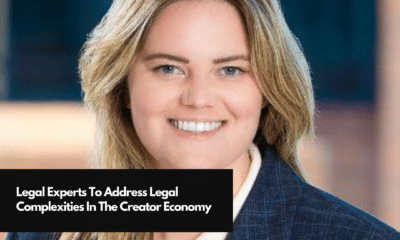Agency
Oli Hills And Nonsensical Lead The Charge In TikTok-Focused Marketing
TikTok marketing agency Nonsensical is building its reputation in the creator economy under the leadership of founder & CEO Oli Hills.

The UK-based firm, launched in 2021, specializes exclusively in TikTok strategies and offers services ranging from organic content management to influencer partnerships.
In an exclusive interview with Net Influencer, Oli shares insights on the future of influencer marketing, the power of micro-influencers, and the industry’s challenges.
His perspective offers a glimpse into the shifting world of social media marketing and the innovative approaches developed to maximize the potential of platforms like TikTok.
Why TikTok? Oli on the Platform’s Unique Appeal
Nonsensical, dubbed “The TikTok Agency,” emerged from the ashes of a social media agency that lost 95% of its revenue during the COVID-19 lockdowns.
Oli’s journey into TikTok began when he noticed the platform’s watermarks appearing on Instagram videos.
“We decided to create some accounts on TikTok and see if we can grow them,” he told us. “We managed to grow two accounts to 800,000 followers combined.”
“And next thing you know, companies approached us and asked for help on TikTok.”
This unexpected turn led to the creation of Nonsensical, which had a clear vision from the start.
“Our plan is always to be the world’s most sought-after TikTok agency,” Oli reveals. “That is what we started. And it’s exactly what we’re still trying to do today.”
Oli’s decision to focus on TikTok was driven by the platform’s approach to social media.
“They made content creation much more accessible with probably the world’s best video editing app that they gave the world for free,” he states.
“Secondly, the distribution model was based around content discovery rather than [the] opt-in model you see by following on the likes of Instagram, Facebook, LinkedIn.”
Nonsensical: A Focused Approach to TikTok Marketing
Oli distinguishes his agency in the competitive industry through a laser-focused approach to TikTok. Recognizing the platform’s potential, the founder decided to specialize strategically.
“It is hard to be a full-service social media agency nowadays,” he explains. “There’s just so much complexity in each channel.”
This specialization allows Nonsensical to offer a comprehensive suite of TikTok-specific services across various sectors.
Oli elaborates, “We have clients within insurance, financial services, FMCG, travel, food, hospitality, leisure… From our perspective, it doesn’t matter what sector you’re in. For us, it’s coming up with the best strategy to get your impact on TikTok.”
Nonsensical’s services include organic content management, paid media campaigns, influencer marketing, and exploring TikTok’s e-commerce features through TikTok Shop.
“We’re creating 10-30 pieces of content monthly and posting them on brand channels, [as well as] creating content for paid ads and then doing the media buying,” Oli notes.
The agency also offers TikTok training for companies looking to develop in-house capabilities. “We do all-day training on creating content to get impact because, unfortunately, TikTok’s a bit weird compared to other social media platforms,” Oli says.
“The standard ways of creating content don’t work on there, and you have to fully embrace TikTok to get success,” Oli adds.
Distinguishing Roles in Digital Marketing
Oli takes a nuanced approach to defining and measuring success in the creator economy. He divides influencers and creators, emphasizing that these roles serve different purposes in marketing strategies.
“We find an influencer to be someone you’re trying to access their community… A creator makes a commissioned piece of content for brands to use, either organically [or] as [an] ad,” Oli points out.
When evaluating influencers, Nonsensical prioritizes audience demographics over follower counts.
“We’re not particularly bothered by followers,” Oli explains. “We’re interested in average views per video and engagement with the video.”
The agency also values influencers who understand the business side of collaborations.
“If an influencer is willing and able to provide an element of guarantee or certainty, as part of the arrangement that we have in place, that’s a key thing we look for,” Oli told us.
For creators, Nonsensical focuses on production quality and the ability to follow briefs effectively, with Oli stating that “the ability to follow a brief is fundamental.”
In selecting influencers, Nonsensical prioritizes niche expertise.
“We have an internal expression about ‘what tok your content sits in,’ which is essentially which audience niche your content is being served within,” Oli reveals.
He argues that this approach allows the agency to target specific audience segments effectively.
Leveraging Local Influence
Oli shares a compelling case study demonstrating the agency’s approach to influencer marketing. The campaign, designed for a UK-based food delivery company, focused on hyper-local activation in northeast England.
“The key thing they were trying to achieve was local activation,” Oli explains. “So they only wanted to speak to people in the northeast of the UK [Newcastle, Sunderland, Middlesbrough].”
Nonsensical’s strategy involved identifying and partnering with local food content creators on TikTok. Despite having relatively small followings, these influencers proved incredibly effective.
“Some of them only had 3500 followers,” Oli notes. “That’s exactly what we needed because we essentially worked with those influencers to produce real, high-quality, localized content with the right accent that understood the local dialect and the nuances of what it means to live in that city.”
By combining organic posts from these micro-influencers with paid media through TikTok’s Spark Ads, Nonsensical drove significant app downloads for the client.
Learning from Challenges
Oli also reflects on less successful campaigns, emphasizing that the quality of content is paramount. He identifies a common pitfall: brands not trusting influencers enough to leverage their unique style and audience connection.
“The biggest challenge many companies have is trusting the influencer,” Oli states. “Because the influencer knows what they’re doing. They have built an audience based on the style of content that they create.”
He advises brands to be flexible and allow influencers to weave brand messages into their content authentically. “If brands try to get us to include logos or overly kind of scripted narrative, it’s just never going to work,” Oli cautions.
This experience has reinforced Nonsensical’s advocacy for influencer autonomy within brand partnerships, Oli concludes.
The Murky Waters of Influencer Marketing
Oli identifies several key challenges in the influencer marketing landscape and offers insights on addressing them. One of the primary issues he highlights is attribution and defining campaign objectives.
“Companies will always want to know the success,” the entrepreneur explains. “I think the step before attribution is why we are doing this. And I don’t think companies fully consider why they work with influencers.”
He emphasizes the importance of clarifying whether a campaign is focused on brand awareness or conversions, as this impacts content strategy and success measurement.
Another significant hurdle is the need for standardized pricing in influencer collaborations.
“It’s baffling that the first price an influencer gives you is always at least 50% over what they accept,” Oli notes, adding that this variability makes it difficult for brands to assess the value of influencer partnerships compared to traditional paid advertising.
He also stresses the critical role of authenticity in influencer marketing, particularly on platforms like TikTok.
“I think the notion of the influencer on Instagram who maybe makes up their life doesn’t necessarily live too well on TikTok, which is a bit more of a rough, ready, behind-the-scenes type of platform,” he observes.
To ensure authenticity, Oli advises influencers to turn down partnerships that don’t align with their values despite financial incentives. He also cautions against confusing large follower counts with genuine influence, emphasizing the importance of engaging, sustainable communities.
The Future of Influencer Marketing: Micro-Influencers, UGC, and Social Commerce
Oli is bullish on micro-influencers’ potential, citing their niche expertise and cost-effectiveness. “There is a niche on TikTok for absolutely everything,” he notes.
He highlights the advantages of micro-influencers: “With all due respect, working with micro-influencers will generally result in cheaper fees.”
The executive also mentions the synergy between micro-influencers and TikTok’s Spark Ads feature. According to him, this combination allows brands to amplify content created by influencers who genuinely understand the platform, potentially leading to better engagement and return on investment.
While acknowledging the benefits of user-generated content, Oli expresses concern about the saturation of UGC creators in the market.
“The big risk is that all of these UGC creators are making a livelihood from creating content, which is awesome. The issue now is that they’re starting to appear on competing brands,” he explains.
To address this challenge, Oli predicts a shift towards “staff-generated content or employee-generated content,” which would bring audiences behind the scenes of organizations.
He also foresees longer-term partnerships between brands and creators: “I think there is going to be this big shift towards how employees within organizations [become] the face of content.”
Looking to the future, Oli is particularly excited about the potential of social commerce platforms like TikTok Shop.
“I think that’s the next layer as well, where you can start working with creators on affiliate commission because it’s guaranteed to be attributed,” he states.
The industry veteran believes this development could solve a long-standing issue in influencer marketing: accurate sales attribution to specific creators.
The Need for Transparency
Oli emphasizes the need for more transparency in the industry. “Transparency of rights,” he states.
“I think it is the Wild West. So many people and brands have been burnt by influencers that will post, get a thousand views, and take the money. And not do anything.”
Oli argues that establishing consistency in pricing and performance expectations would immensely benefit the industry. “It’s hard to know what good value is out there,” he explains, noting that transparency might not solely be about price but also performance guarantees.
“It may be based on influencers understanding that I need to get an element of a return from this,” Oli elaborates. “[We need] to be able and willing to have a conversation about what [the parties] can commit to or guarantee as part of [a] campaign.”
Oli advocates for open communication and flexibility in influencer partnerships. He advises brands to be open to creators’ content ideas while urging creators to be flexible in negotiations.
“Think about it as a long-term partnership,” he suggests, predicting a move towards longer-term ambassadorial relationships between brands and influencers.





















